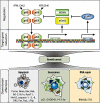Translational approaches targeting the p53 pathway for anti-cancer therapy
- PMID: 21718309
- PMCID: PMC3268188
- DOI: 10.1111/j.1476-5381.2011.01570.x
Translational approaches targeting the p53 pathway for anti-cancer therapy
Abstract
The p53 tumour suppressor blocks cancer development by triggering apoptosis or cellular senescence in response to oncogenic stress or DNA damage. Consequently, the p53 signalling pathway is virtually always inactivated in human cancer cells. This unifying feature has commenced tremendous efforts to develop p53-based anti-cancer therapies. Different strategies exist that are adapted to the mechanisms of p53 inactivation. In p53-mutated tumours, delivery of wild-type p53 by adenovirus-based gene therapy is now practised in China. Also, remarkable progress has been made in the development of p53-binding drugs that can rescue and reactivate the function of mutant or misfolded p53. Other biologic approaches include the development of oncolytic viruses that are designed to specifically replicate in and kill p53-defective cells. Inactivation of wt-p53 frequently results from dysregulation of MDM2, an E3 ligase that regulates p53 levels. Small-molecule drugs that inhibit the interaction of MDM2 and p53 and block p53 degradation are currently tested in clinical trials. This survey highlights the recent developments that attempt to modulate the function of p53 and outlines strategies that are being investigated for pharmacological intervention in the p53 pathway.
© 2011 The Authors. British Journal of Pharmacology © 2011 The British Pharmacological Society.
Figures


References
-
- Arts J, Page M, Valckx A, Blattner C, Kulikov R, Floren W, et al. 2008. p. 1592. JNJ-26854165 – a novel hdm2 antagonist in clinical development showing broad-spectrum preclinical antitumor activity against solid malignancies. AACR Meeting Abstracts 2008.
-
- Auclair C. Multimodal action of antitumor agents on DNA: the ellipticine series. Arch Biochem Biophys. 1987;259:1–14. - PubMed
-
- Bazan-Peregrino M, Carlisle RC, Hernandez-Alcoceba R, Iggo R, Homicsko K, Fisher KD, et al. Comparison of molecular strategies for breast cancer virotherapy using oncolytic adenovirus. Hum Gene Ther. 2008;19:873–886. - PubMed
Publication types
MeSH terms
Substances
LinkOut - more resources
Full Text Sources
Other Literature Sources
Research Materials
Miscellaneous

